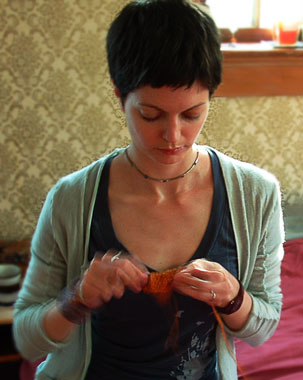Crochet v. Knit

CROCHET v. KNIT—it sounds like an epic battle waged by yarn crafters. It isn’t, but even if it were, it would be impossible to establish a victor. To a longtime, die-hard crocheter, it feels like there are more knitters and more knitting patterns available. Often, LYSs call themselves knitting studios, leaving crochet as an afterthought, mostly offering knitting classes. Knitters dominate social networking sites like Reddit 1, 2 and Ravelry3, 4 and appear to have more followers on Facebook and Pinterest. And yet, the results from the Craft & Hobby Association’s 2010 research study revealed that crocheting is ranked seventh in craft sales (knitting did not make the top ten) and third in household participation, clocking in at 17.4 million to knitting’s 13 million.5 On top of that, the Craft Yarn Council’s 2011 research study discovered that 23% of respondents only crochet compared to 14% that only knit, while 63% both crochet and knit.6
That last statistic really pleases me; I love the idea that yarn crafters are not locked in battle at all but sharing in a little bit of both crafts. Really, this makes sense, for crocheting and knitting are each adept at different aspects of yarn crafting and should be appreciated for their specific talents.
Crocheted fabric is generally thicker than knitted fabric, and its creation is more unconstrained, so it lends itself to certain projects and techniques. It is a natural choice for sculptural items, like amigurumi. Crochet is also great for lace: filet crochet lace, Irish lace crochet, and freeform crochet lace are all beautiful examples. Compared to knitting, crochet is usually the faster craft, and it can also use up more yarn.
Knitting is amazing at tubes, perfect for the bodies of sweaters, for sleeves, and, especially, for socks. It has great stretch for collars and cuffs. Knitted fabrics have wonderful drape and are usually thinner and less stiff than crocheted fabrics, making it a common choice for clothing items. Knitted projects may seem to take forever to materialize while they are being made, but they are worth the wait.
Despite their differences, each craft is quite good at accomplishing the specialties of the other craft. Crocheted fabric can be thin and drapey, especially when the crocheter picks thinner yarns and larger hooks sizes.8 Certain fibers such as cotton, linen, silk, alpaca, mohair, and bamboo can help with drape as well.9 Sculptural items and lace are alsopossible in knitting just as cables are in crochet. Intricate colorwork is native to both crafts: knitting has Intarsia, Fair Isle, and Slip Stitch, and crochet has Tapestry.
To ask which is the better yarn craft is to invite a heated debate with no clear winner. There isn't even agreement on which craft is easier to learn and to work in. For each person, the easier craft is probably the one the crafter learned first. Yet, through all of the differences and crossover between crocheting and knitting, some of the best projects I have run across useboth crafts in the same project. A knitted sweater body with crocheted arms, a crocheted sweater with knitted collar and cuffs, crochet dolls with little knit clothes, the combinations are delightful and endless. So don’t choose! Do them both! And see your projects and skills blossom because of it.
1 Reddit Statistics on Crochet. stattit.com.
2 Reddit Statistics on Knitting. stattit.com.
3 Crochet Patterns on Ravelry. ravelry.com.
4 Knitting Patterns on Ravelry. ravelry.com.
5 CraftPR. CHA Annouces 2010 Craft Industry Statistics. craftandhobby.com.
6 Knitting & Crochet Are Hot! craftyarncouncil.com.
7 Chan, Doris. Blocking Crochet: Just Do It. dorischancrochet.com.
8 Werker, Kim. Talking to Knitters About Crochet. knittingdaily.com.
9 Wheeler, Laurie. Drape & Crochet: What It Is and How to Achieve It. crochetliberationfront.com.
